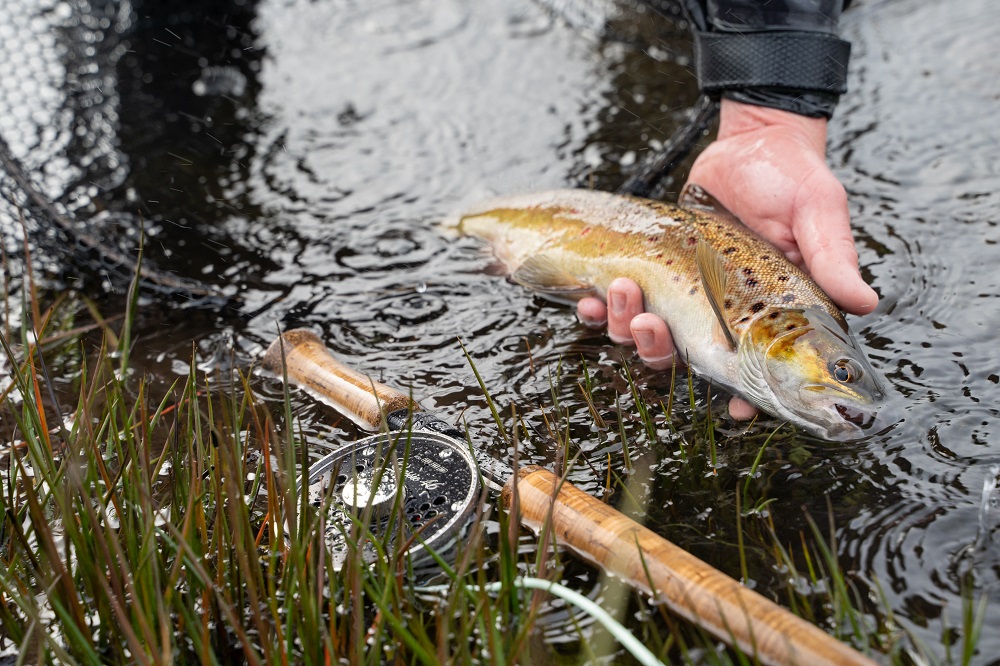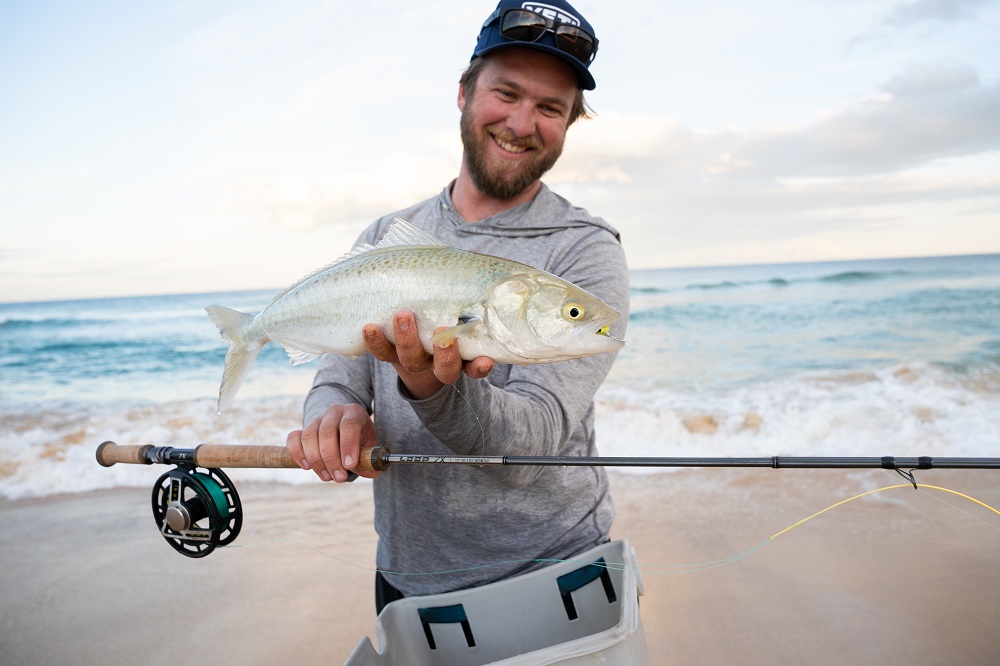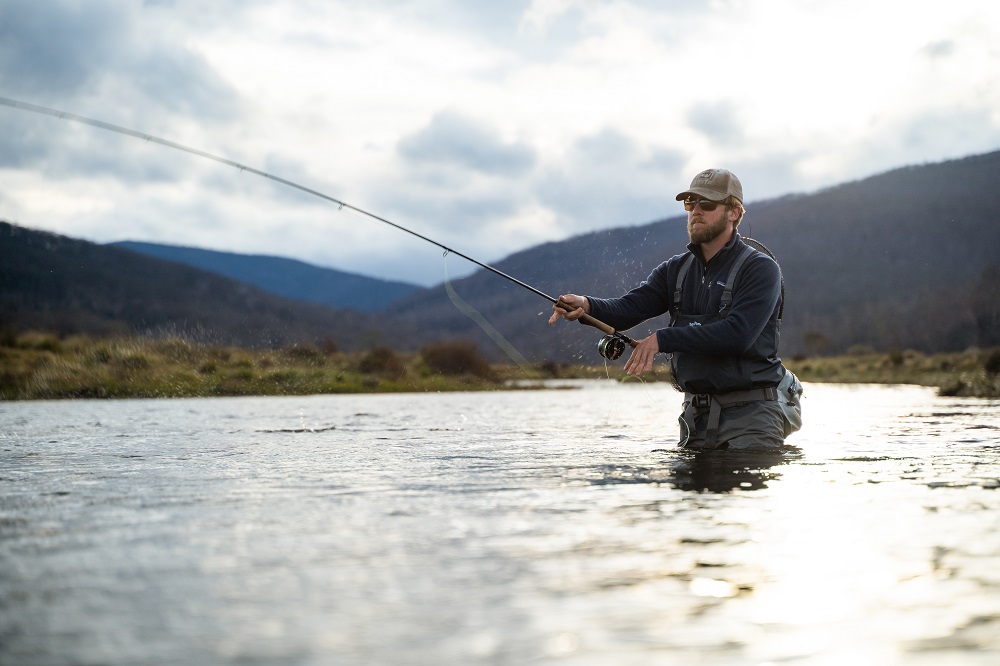
Two-handed rods have way more application in Australia than you might think, writes Mickey.
I love two-handed fishing for a variety of reasons. What I really like to do though, is cast a two-handed rod, make a well thought through presentation, and have a decent chance of catching a fish!
I’m a simple man of simple pleasures. I learnt how to two-hand fish in New Zealand years ago on the Tongariro delta, where the rainbows run brawling currents and eat on the swing with devastating force. My growing habit was reinforced over years in Montana on the infinite riffles of the big western rivers, where cutthroat were king and Trout-Spey was all the rage. I finally reached full junkie status a year or so ago in Tierra Del Fuego – I would do anything to feel the next tug from a chrome sea-run brown trout.
The only problem with Australia is that at a glance, we don’t have many big freshwater rivers, and of those, not many are well suited to swinging a fly. I was wholly addicted to something that I thought I couldn’t do in the country where I mostly live and work. Well, that all changed a few years ago when my addiction forced me to explore, think a little differently, and find new ways to get my two-handed fix.
Two-handed evolution down-under
Australia is somewhat unique in the two-handed world. In most countries, two-handed casting evolved out of necessity and then became a fun diversion in its own right; in Australia, the opposite is more commonly the case. Two-handed fishing comprises several interesting concepts which trickled down to anglers here through the growing use of two-handed rods internationally. We are now at the stage in this country where anyone can lose themselves in endless theories of Scandi vs. Skagit online, or go to a local paddock or footy field to cast a two-hander to their heart’s content.
Two-handed casting has evolved as a fun diversion and skill in its own right in Australia; what’s missing at a glance is the type of water which makes sense for two-handed fishing – mainly large, cold rivers which salmonids love and which are perfect for swinging. However, once you go beyond a glance, you can in fact find a few of those types of rivers in Australia. And if you completely go beyond what two-handers have traditionally been used for, there are all kinds of other, innovative ways to use two-handed rods for fishing down-under.
Tailwaters
As mentioned above, Australia does not have many obvious places to swing a fly on two-hand gear, but it does have some excellent swinging water once you dig a little deeper. Like all countries we have dams, and those dams have tailwaters. A dam that has consistent outflows of cold water which can sustain trout, is relatively rare in Australia. Of course, we do have an abundance of trout water: high alpine lakes and rivers that are teeming with excellent brown, rainbow and brook trout. However most of this water, where I used to do the majority of my guiding, is simply too small for two-handers most of the time.
Then a few years ago, I went back to a tailwater I’d long fished during its short periods of low flows. A lengthy tailwater by Australian standards (nearly 100km of trout water) the Tumut River offers cold water all season. With an abundance of trout, it’s an ideal tailwater for drifting – and importantly for my nagging addiction, at typical flows, it’s the right size for swinging a fly on a two-hander. I moved house, set up a drift boat and began guiding on this river – and fishing it in my free time with my 5 weight 11ft switch rod.
What I found was spectacular: a perfect ‘pocket size’ swinging river which was home to energetic chubby rainbows and some perfect out-size browns. I can now throw everything I want to: big streamers on Skagit heads, light nymphs on Scandi gear… I can even skate caddis or mice if I feel like it. I now I live a 300m walk from a perfect Trout-Spey river I can work or play on. Over the ensuing years, I’ve explored a few other excellent Australian tailwaters and I’m gradually building towards fishing all of them successfully.
Now at this point, you could be forgiven for thinking that my addiction was satisfied and that’s the end of the story. But you’d be wrong.
Salt
While our country has a limited amount of freshwater, it's the complete opposite with saltwater. There are more saltwater fishing opportunities here than most other countries on the planet, and a few that are perfectly suited to a two-handed approach.
I don’t tend to think of saltwater two-handed fishing in terms of tropical flats and sight fishing. That’s because two-handed fishing is not all about pinpoint accuracy and split-second directional change; those are the characteristics that make single hand casting useful. The really valuable aspect of two-handed fishing is you can cover a large area of water super-efficiently. That’s why two-handed fishing is so effective for searching saltwater. I’m by no means a champion distance caster with a single or double-handed rod, but I regularly throw a full fly-line with relative ease with all of my two-handed rods. This feature becomes very handy for a lot of south-east Australian saltwater flyfishing, especially the estuaries and beaches we all fish so regularly.
In an estuary, I tend to use traditional weight-forward floating or sinking lines as you would fish with a single hand rod. The main advantage is, I can cast distance with ease and without hauling. Additionally, with a light two-hander, I can also cast accurately to snags or at specific fish with one or two hands. So, I can bomb a cast out blind along a drop-off or flat and strip back like a madman for a flathead in shallow water, or I can motor up to a snag and place a fly way back in for bream, bass or estuary perch.
Off the beach, I use shooting heads cast overhead, and shoot mono running line out past the breaking surf. This allows me to drift inert presentations like sea-worm or weed flies out the back of the wash for blackfish and bream, or I can strip baitfish patterns like Clousers to catch the eye of Australian salmon, one of our most underrated fish on fly. The running line being mono, it also has the advantage of not being caught up in the beach break and drifting my shooting head back toward me too soon.
Lakes
Moving back to the fresh but in keeping with the theme of covering water efficiently, impoundments are awesome canvases to paint with a two-hander. On our trout lakes, a two-hander is a fantastic addition for any boat or bank-based angler. As with two-hander estuary fishing described above, I tend to cast traditional weight-forward lines for most of the same reasons. I can cast ‘normal’ lines easily with a proper switch rod either single or double handed, water-loaded or overhead.
The advantage of using a regular weight-forward fly line on a trout lake is two-fold: I can get a better presentation with a ‘normal’ line than I can with a shooting head, and when using sinking lines, I can keep a set depth a lot more easily with a full sinking line than I can with a sink tip attached to a shooting head. What you lose in distance with a ‘traditional’ line vs a shooting head, you make up for in fishability.
A two-hander in these situations is all about efficiency rather than pure distance. The idea is, you are able to cast 70ft again and again, accurately and without fatigue. This has become especially relevant to me this season on Murray cod impoundments. With one or two false casts and no hauls, my 13’6” 8 weight can easily throw 70 or 80 feet of sinking line and a 10-inch cod fly.
Initially, I thought the rod’s length would make it ineffective for cod through not being able to cast accurately enough, or being able to feel the fly properly through the retrieve. However, I’ve found the two-hander has increased my casting rate by almost 2 to 1 – so I’m doubling the amount of time the fly is in the water. And with a bit of practice, I can hit a snag almost as accurately as I can with a single hander.
The long rod has proved an advantage when fishing boat or bank. From a boat, I end up being able to hang a fly further off my rod tip and deeper – which in the case of following cod is always an advantage. Plus, the added length means I now almost exclusively two hand retrieve with the rod tucked under my arm. I can still get all the action I want out of this style of retrieve, and I have great feel for what my fly is doing. Plus, it is physically impossible to trout strike!
Overhead casting vs. water-loading
No matter where or how you are fishing with a two-hander, you can always choose either a water-loaded cast or an overhead cast. The trick is knowing which one to make and when. I tend to overhead cast a fair bit more with my two-handers than water-load them, which seems backwards to most people. Overhead casting however is more efficient in a lot of the circumstances and with a lot of the lines I use. If I’m using traditional lines on a lake or estuary, I tend to start off with a short roll cast (a water-load) then transition into overhead casting. This is efficient and gives me a great presentation.
If I’m swinging a river, more often than not I will stick with water-load casts: they’re the most efficient way to go. At the beach I’m always casting overhead – it allows me to cast off the sand or rocks and I don’t need to hang around in the break attempting to set an anchor in the water.
The most common problem when beginning to use two-handers is wanting to water-load every cast. Even on a trout lake, if you consistently water-load with a normal weight-forward line, then you’ll have to set multiple anchors gradually getting longer and longer. This tends to scare anything in your immediate vicinity. Another big plus of overhead casting is being able to change direction to an extent mid-cast. If you’re fishing to cruising fish or rises you can adjust mid-air.
Water-loading is a super valuable tool though, and definitely an awesome and efficient way to fish. For instance, I spent a lot of late autumn water-loading a very high-flowing Eucumbene River. The key point is, as you broaden your two-hand horizons, you need to use the cast that suites the situation.
Gear
As far as gear goes, for Australian two-handed fishing you only need one rod to rule them all: a good switch rod. A switch rod (as I’d define it for our purposes) is a rod that casts equally well single-handed or with both hands. I use a 4 weight 11ft that I like for a number of reasons, including that 4 weight is just about perfect for most of the uses I’ve described above. I also have a 5wt 11ft which I like for some heavier work, though keeping it light is the best way to go.
My exception is a 13ft 8 weight, but that is a select tool for a specific job (casting in cod impoundments) which I do a lot of, so it was worth the investment. More generally, the lighter the rod, the easier it is to cast single handed – which is really useful in some situations. If you want to, you can add a quick haul when fishing shooting heads for a maximum fast load, or shoot a cast accurately into snags and be able to stop the line and get your fly to turn over exactly where you want it.
I like an 11-foot rod, but I wouldn’t go much longer. Rods longer than that become too tip heavy to cast comfortably single-handed. I’ve found that I split my casting 50/50 between single and two-handed, so make sure you throw a few casts single-handed when you’re trying out prospective rods. A fast action or medium-fast action is the way to go. While slow action or glass rods are really nice to swing with, most are specialty tools that won’t tick all the boxes.
As far as reels go, you want a 6-8 weight, large arbour reel and if you’re going to use it in the salt, get one with a good sealed drag.
And you’ll definitely want to buy or make a stripping basket: line management on a boat, a beach or the lake becomes a whole lot easier. You might even want a wetsuit for the winter salmon! Think outside the box and solve problems as they come up.
Overall, get out there and catch some weird species in some fun and practical ways. Think about different lines and systems you can use these rods for. There are people out there solving all kinds of unique problems or making life easier with two-handed rods. See if you can come up with a new way to do it down-under.
FLYSTREAM FACTS - The Grain/ Weight dark hole
Lines are extremely important, the key to your set-up. You can always get away with a rod that may not be top of the range, IF you get a great line to go on it. To fish all of the styles I’ve mentioned above, it’s best to have one rod and a few different lines: ‘normal’ weight-forward lines; plus Skagit or Scandi lines. For my ‘normal’ lines I like a weight-forward floating 6 weight. I use a SA MPX, and a SA Sonar Intermediate Camo line. Once you find the weight of line your rod likes to throw, you can pretty well shop in that band for ‘normal’ lines and get whatever you need for your purpose.
When it comes to Spey, Scandi and Skagit lines, I use a few different shooting heads and running line combos for different purposes. I like Scandi lines on textured running lines for most of my Trout-Spey work, wet flies or swinging nymphs. Scandi heads get the best presentation for this type of fishing and textured running lines are the easiest to mend with and fish with. I use Skagit lines with mono running line when I need maximum distance: the mono shoots so well, there are few other line combos that are so easily going to increase your distance.
There is way too much information out there about grain weights, casting systems etc. The best possible thing you can do is go to a fly shop, get different rods and cast them with different lines. Look at the manufacturer’s suggestions, try them out and see what works for you, but keep it simple and practical. I like using 6 weight ‘normal’ lines on my 4 weight, or 275 grain Scandi lines and 350 grain Skagit lines, but I’ve tested out a few line weights to come to that conclusion. Never buy any fly-line without testing it – or at least something similar to it.

















